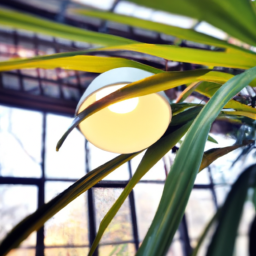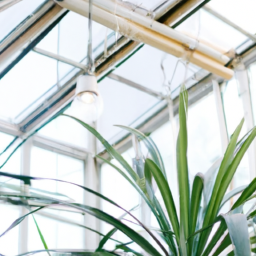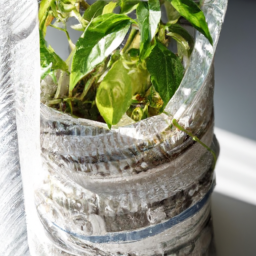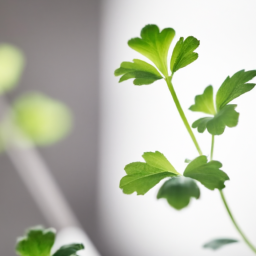
Are you looking to enhance your indoor gardening experience with the help of indoor greenhouse lights? Whether you’re a seasoned plant enthusiast or just starting out with your green thumb, finding the right lighting solution can make all the difference in the success of your indoor garden. In this blog post, we’ll explore the benefits of using indoor greenhouse lights, the different types available, and how to choose the best option for your specific needs. Let’s shed some light on this important aspect of indoor gardening!
Benefits of Using LED Grow Lights in Indoor Greenhouses
Introduction
When it comes to growing plants indoors, having the right lighting is crucial for their growth and development. LED grow lights have become increasingly popular among indoor gardeners due to their numerous benefits. In this article, we will explore the advantages of using LED grow lights in indoor greenhouses and why they are a great choice for your plants.
Energy Efficiency
LED grow lights are known for their energy efficiency, making them a cost-effective option for indoor greenhouse lighting. Unlike traditional lighting sources such as incandescent or fluorescent lights, LEDs consume significantly less energy while providing the same amount of light. This means lower electricity bills and reduced energy consumption, making it a sustainable choice for indoor gardening.
In addition, LED grow lights produce very little heat compared to other lighting options, reducing the need for additional cooling systems in your indoor greenhouse. This not only saves you money on cooling costs but also creates a more stable environment for your plants to thrive in. The energy efficiency of LED grow lights makes them an environmentally friendly choice for indoor gardening.
LED grow lights also have a long lifespan, lasting up to 50,000 hours or more depending on the quality of the light. This means less frequent replacement of bulbs, further reducing costs and maintenance. With their energy efficiency and long lifespan, LED grow lights are a smart investment for indoor greenhouse lighting.
Another advantage of LED grow lights is their versatility in terms of spectrum control. LED lights can be customized to emit specific wavelengths of light that are optimal for plant growth at different stages. This means you can adjust the light spectrum to meet the needs of your plants, promoting healthy growth and maximizing yield. The ability to control the light spectrum with LED grow lights gives you greater flexibility in your indoor gardening setup.
Plant Growth and Yield
LED grow lights are designed to provide plants with the optimal light spectrum for photosynthesis, promoting healthy growth and higher yields. Unlike traditional lighting sources that emit a broad spectrum of light, LED grow lights can be tailored to emit specific wavelengths that are most beneficial for plant growth. This targeted light spectrum can enhance photosynthesis and improve overall plant health, leading to faster growth and increased yield.
LED grow lights also produce very little heat compared to other lighting options, reducing the risk of heat stress on your plants. Excessive heat can damage plant tissues and inhibit growth, so maintaining a stable temperature in your indoor greenhouse is essential for plant health. LED grow lights help create a balanced environment for your plants to thrive in, resulting in healthier growth and higher yields.
In addition, LED grow lights are known for their uniform light distribution, ensuring that all parts of your plants receive adequate light for photosynthesis. This even light distribution can prevent shading and promote consistent growth throughout your plants. With LED grow lights, you can be confident that your plants are receiving the right amount of light they need to flourish.
Furthermore, LED grow lights have a high light output per watt, meaning they can produce more light using less energy. This efficiency not only saves you money on electricity bills but also provides your plants with the intense light they need for optimal growth. LED grow lights are a powerful lighting solution for indoor greenhouses, promoting healthy plant growth and maximizing yield.
In conclusion, LED grow lights offer numerous benefits for indoor greenhouse lighting, from energy efficiency and spectrum control to promoting plant growth and higher yields. By investing in LED grow lights for your indoor gardening setup, you can create a sustainable and productive environment for your plants to thrive in.

Factors to Consider When Choosing Indoor Greenhouse Lights
Light Spectrum
When choosing indoor greenhouse lights, one of the most important factors to consider is the light spectrum. Different plants have different light requirements, so it’s essential to choose lights that provide the right spectrum for your specific plants.
Full-spectrum lights, such as LED grow lights, are a popular choice for indoor greenhouse lighting because they provide a wide range of light wavelengths that are beneficial for plant growth. These lights mimic natural sunlight and can help plants thrive indoors.
It’s also important to consider the color temperature of the lights. Cool white lights (5000-6500K) are ideal for promoting vegetative growth, while warm white lights (2700-3000K) are better for flowering and fruiting plants. Some growers also use red and blue LED lights to target specific growth stages of plants.
In addition to the light spectrum, the intensity of the light is also important. Make sure to choose lights with the right intensity for your plants, as too much or too little light can have negative effects on plant growth.
Energy Efficiency
Another important factor to consider when choosing indoor greenhouse lights is energy efficiency. LED grow lights are known for being energy-efficient, as they consume less electricity than traditional lighting options such as fluorescent or incandescent lights.
Not only do LED lights help you save on energy costs, but they also produce less heat, which can be beneficial for maintaining optimal growing conditions in your indoor greenhouse. High-intensity discharge (HID) lights are another option for indoor greenhouse lighting, but they tend to be less energy-efficient and produce more heat than LED lights.
When comparing different types of lights, make sure to look at the wattage and the light output to determine the energy efficiency of each option. Investing in energy-efficient lights can help you save money in the long run and reduce your environmental impact.
Durability and Longevity
When setting up an indoor greenhouse, it’s important to choose lights that are durable and long-lasting. LED grow lights are known for their durability and longevity, as they can last for up to 50,000 hours or more. This means you won’t have to replace your lights as often, saving you time and money in the long run.
In contrast, traditional lighting options such as fluorescent or incandescent lights have a shorter lifespan and may need to be replaced more frequently. High-quality LED lights are built to withstand the rigors of indoor greenhouse environments, such as high humidity and fluctuating temperatures.
When choosing lights for your indoor greenhouse, make sure to look for lights that are made from high-quality materials and have a solid construction. Investing in durable and long-lasting lights will ensure that your plants receive the light they need to thrive, without the hassle of frequent replacements.
In conclusion, when choosing indoor greenhouse lights, it’s important to consider factors such as light spectrum, energy efficiency, and durability. By selecting lights that provide the right spectrum for your plants, are energy-efficient, and are built to last, you can create an optimal growing environment for your indoor greenhouse. Choose wisely and watch your plants flourish under the right lighting conditions.

Best Practices for Setting Up Indoor Greenhouse Lighting Systems
Understanding the Importance of Indoor Greenhouse Lights
When it comes to setting up an indoor greenhouse, proper lighting is essential for the growth and development of your plants. Indoor plants rely on artificial lighting to mimic the natural sunlight they would receive outdoors. Without the right lighting conditions, your plants may not be able to photosynthesize properly, leading to stunted growth or even death.
There are a variety of indoor greenhouse lights available on the market, each with its own benefits and drawbacks. It’s important to choose the right lighting system for your specific needs and the types of plants you are growing. LED lights are a popular choice for indoor greenhouse setups due to their energy efficiency and customizable spectrum options. Fluorescent lights are another common option, providing a good balance of light intensity and cost-effectiveness.
When setting up your indoor greenhouse lighting system, it’s important to consider factors such as light intensity, duration, and spectrum. Different plants have different light requirements, so be sure to research the specific needs of the plants you are growing. In general, most plants require around 12-16 hours of light per day for optimal growth.
Choosing the Right Lighting Setup
When selecting indoor greenhouse lights, there are a few key factors to consider. The first is light intensity, which refers to the brightness of the light and is measured in lumens or lux. Different plants have different light intensity requirements, so be sure to choose lights that provide the right level of brightness for your specific plants.
Another important factor to consider is the light spectrum. Plants require different wavelengths of light for photosynthesis, with blue light promoting vegetative growth and red light stimulating flowering. Many LED lights allow you to customize the spectrum to meet the specific needs of your plants.
In addition to light intensity and spectrum, it’s important to consider the durability and energy efficiency of the lights you choose. LED lights are known for their long lifespan and low energy consumption, making them a popular choice for indoor greenhouse setups. Fluorescent lights are also energy-efficient, but may not last as long as LED lights.
Setting Up Your Lighting System
Once you have chosen the right indoor greenhouse lights for your setup, it’s time to install and set them up. Start by positioning the lights above your plants at the appropriate height to ensure even light distribution. Most plants require the light to be placed 6-12 inches above the canopy, but be sure to check the specific requirements for your plants.
Next, set a timer to control the duration of light exposure. Most plants require around 12-16 hours of light per day, so set your timer accordingly. It’s important to maintain a consistent light schedule to ensure the health and growth of your plants.
Finally, monitor your plants regularly to ensure they are receiving the right amount of light. Adjust the height and intensity of the lights as needed to meet the specific needs of your plants. With the right indoor greenhouse lighting system in place, you can enjoy healthy, thriving plants year-round.
Let’s bring it all home
If you’re looking to grow plants indoors, one key component you’ll need to consider is the type of lighting you’ll use. Indoor greenhouse lights are essential for providing the necessary light spectrum for plants to thrive. There are several options available, including LED, fluorescent, and HID lights, each with its own benefits and drawbacks.
LED lights are energy-efficient and long-lasting, making them a popular choice for indoor gardening. They also emit very little heat, which can be beneficial for maintaining a consistent temperature in your growing space. Fluorescent lights are another option that is more affordable and widely available. They are suitable for smaller plants or seedlings but may not provide enough light for larger, more mature plants. HID lights are the most powerful option, providing intense light that is ideal for larger plants or those that require a lot of light. However, they can be more expensive to operate and may require additional cooling to prevent overheating. Ultimately, the best choice for your indoor greenhouse will depend on your specific needs and budget.
Here are some FAQs you’d be interested in:
Q1. What are the benefits of using indoor greenhouse lights?
A1. Indoor greenhouse lights provide the necessary light spectrum for plants to photosynthesize and grow effectively, regardless of the outdoor conditions. They also allow you to control the lighting schedule for your plants, leading to better growth and healthier yields.
Q2. What types of indoor greenhouse lights are available?
A2. There are various types of indoor greenhouse lights available, including fluorescent, LED, and high-intensity discharge (HID) lights. Each type has its own set of advantages and is suitable for different types of plants and growth stages.
Q3. How do I choose the right indoor greenhouse lights for my plants?
A3. When choosing indoor greenhouse lights, consider factors such as the type of plants you are growing, the size of your growing space, and your budget. LED lights are energy-efficient and long-lasting, while HID lights are powerful and provide intense light.
Q4. How far should indoor greenhouse lights be from my plants?
A4. The distance between your indoor greenhouse lights and your plants depends on the type of light and the stage of growth. Generally, LED lights can be placed closer to plants, while HID lights should be positioned further away to prevent burning.
Q5. Do indoor greenhouse lights produce heat?
A5. Yes, indoor greenhouse lights do produce heat, especially HID lights. It is important to monitor the temperature in your growing space and provide adequate ventilation to prevent overheating and ensure optimal growing conditions for your plants.
Dr. Olivia Green is a botanist with over two decades of experience in indoor plant cultivation. She holds a Ph.D. in Plant Biology and has dedicated her career to researching plant behavior in controlled environments. Dr. Green is passionate about helping plant enthusiasts master the art of indoor gardening through her extensive knowledge and practical insights.


